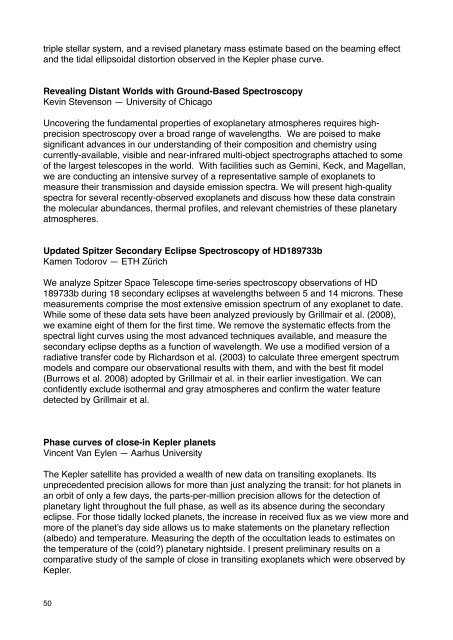Exoclimes_Conference_booklet1
Exoclimes_Conference_booklet1
Exoclimes_Conference_booklet1
You also want an ePaper? Increase the reach of your titles
YUMPU automatically turns print PDFs into web optimized ePapers that Google loves.
triple stellar system, and a revised planetary mass estimate based on the beaming effect<br />
and the tidal ellipsoidal distortion observed in the Kepler phase curve.<br />
Revealing Distant Worlds with Ground-Based Spectroscopy<br />
Kevin Stevenson — University of Chicago<br />
Uncovering the fundamental properties of exoplanetary atmospheres requires highprecision<br />
spectroscopy over a broad range of wavelengths. We are poised to make<br />
significant advances in our understanding of their composition and chemistry using<br />
currently-available, visible and near-infrared multi-object spectrographs attached to some<br />
of the largest telescopes in the world. With facilities such as Gemini, Keck, and Magellan,<br />
we are conducting an intensive survey of a representative sample of exoplanets to<br />
measure their transmission and dayside emission spectra. We will present high-quality<br />
spectra for several recently-observed exoplanets and discuss how these data constrain<br />
the molecular abundances, thermal profiles, and relevant chemistries of these planetary<br />
atmospheres.<br />
Updated Spitzer Secondary Eclipse Spectroscopy of HD189733b<br />
Kamen Todorov — ETH Zürich<br />
We analyze Spitzer Space Telescope time-series spectroscopy observations of HD<br />
189733b during 18 secondary eclipses at wavelengths between 5 and 14 microns. These<br />
measurements comprise the most extensive emission spectrum of any exoplanet to date.<br />
While some of these data sets have been analyzed previously by Grillmair et al. (2008),<br />
we examine eight of them for the first time. We remove the systematic effects from the<br />
spectral light curves using the most advanced techniques available, and measure the<br />
secondary eclipse depths as a function of wavelength. We use a modified version of a<br />
radiative transfer code by Richardson et al. (2003) to calculate three emergent spectrum<br />
models and compare our observational results with them, and with the best fit model<br />
(Burrows et al. 2008) adopted by Grillmair et al. in their earlier investigation. We can<br />
confidently exclude isothermal and gray atmospheres and confirm the water feature<br />
detected by Grillmair et al.<br />
Phase curves of close-in Kepler planets<br />
Vincent Van Eylen — Aarhus University!<br />
The Kepler satellite has provided a wealth of new data on transiting exoplanets. Its<br />
unprecedented precision allows for more than just analyzing the transit: for hot planets in<br />
an orbit of only a few days, the parts-per-million precision allows for the detection of<br />
planetary light throughout the full phase, as well as its absence during the secondary<br />
eclipse. For those tidally locked planets, the increase in received flux as we view more and<br />
more of the planet's day side allows us to make statements on the planetary reflection<br />
(albedo) and temperature. Measuring the depth of the occultation leads to estimates on<br />
the temperature of the (cold) planetary nightside. I present preliminary results on a<br />
comparative study of the sample of close in transiting exoplanets which were observed by<br />
Kepler.<br />
50


